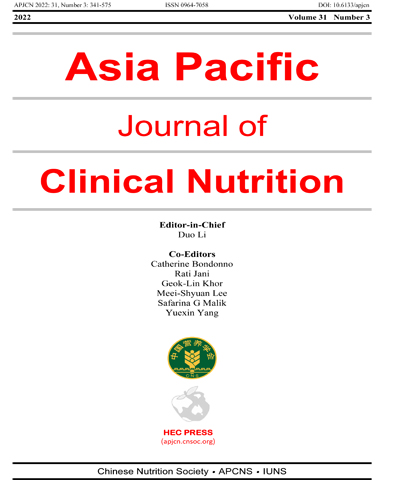
Asia Pacific Journal of Clinical Nutrition/亞太地區臨床營養期刊
- Ahead-of-Print
HEC Press,正常發行
選擇卷期
- 期刊
維生素D的功能是透過某些途徑多效地影響全身器官及系統。足量的維生素D主要靠陽光中的紫外線刺激皮膚合成及含有維生素D的食物,如來自動物或菇菌類中所含的維生素D-3與D-2,分別由去氫膽固醇與麥角固醇合成。因此,體內維生素D的狀況易受到環境影響。隨著生態系統的衰落,不管是大氣污染或是因為養殖漁業、菇類加工使這些食物無法保有經由紫外線輻射而產生的維生素D,此營養素進入人體的機會可能隨之減少。目前東北亞維生素D缺乏的情形和他處一樣常見且普遍。在20世紀初,維生素D被發現與孩童佝僂症和成人的軟骨症有關,當時那一輩的孩童藉由給與魚肝油(通常是鱈魚)來防止骨疾病。然而現在,鱈魚及許多可食的魚類數量均銳減,過度暴露於陽光下則會增加皮膚癌的風險。為了解決此問題,也許應以維生素D補充劑來取代魚肝。但是人口增加及老化(此時皮膚對紫外線的反應降低)的壓力使得臨床及公共衛生上的決策變得不可或缺。維生素D狀況已成為糧食安全的代言,其常用指標為食物多樣性;此多樣性或許使得以較少的濃度就能在器官和系統功能更有效率,但目前支持的證據尚不足。
- 期刊
營養不良的雙重負擔(DBMN),係指營養不足及營養過剩同時存在相同的族群,在發展中國家包含泰國,這是一個新近浮現的公共衛生問題。本篇文章使用大規模的國家性調查資料,回顧從低收入轉變為中等收入國家的過程中,婦幼營養的情況及趨勢。1980年代之前,蛋白質熱量營養不良及微量營養素缺乏顯著地影響媽媽及幼兒。這個情況在1980-1990年代,因多部門政策及計劃致力於執行扶貧及初級健康照護而大幅的改善。經濟的發展,改善健康服務的可近性及有效率的社區基礎營養計畫造就這些正向趨勢。然而,1990年代低出生體重的盛行率保持在8-10%,生長遲緩及體重過輕下降至約10%,爾後小幅度改變。懷孕婦女及兒童的貧血盛行率減少一半,而維生素A缺乏不再是公共衛生問題。碘缺乏,特別是懷孕期間,仍然是重要的關注點。當國家朝經濟及社會方面的發展前進,各個社經層面的婦女及兒童都受營養過剩的影響。在市鎮及鄉村地區都觀察到生活型態、食物可近性及飲食模式的改變。儘管已做出努力因應這些挑戰,針對複雜的社經環境中的DBMN問題,仍迫切需要一致性的政策及計畫。解決兒童肥胖及慢性疾病議題的同時,應考量幼兒期的營養不足。
- 期刊
因為畜牛會產生溫室效應的甲烷氣體,故一些名人提倡少吃肉或是成為素食者,以減少全球暖化。這牽涉幾個問題包含:世界上許多原先放牧畜牛的那些草原會變成如何;替代蛋白質如何被生產以及那個產物的溫室結果將會是什麼?這歸結到生產系統。世界上的農地有70%是草原,從草原生產糧食只有一個方法,就是放牧反芻類動物。假如沒有在草原放牧家畜,原生或是野生反芻類動物會遷移進去,也產生甲烷。餵食畜牛高品質穀類的做法是更難站得住腳的。以植物性蛋白替代動物性蛋白,例如大豆,需要使用較多耕地、水、燃料及化學物質。一個較合理的糧食系統應該是將牛群放養在草原上,而不餵食牠們高品質穀物。這樣反而有更多現行的作物可提供人類食用。
- 期刊
背景:本研究之目的是探討鹽攝取量與尿鹽排出量之相關性,並檢查用來測量24小時尿鹽排出的自我監測裝置之校度。方法:12位健康的年輕女性自願者,攝取14天的實驗餐並藉由自我監測裝置來測量其第2天到第15天的尿鹽排出量。實驗餐中所含的鹽量分別如下:10克(第1到5天)、6克(第6到8天)、13克(第9到11天)、6克(第12天)、13克(第13天)、及6克(第14天)。結果:由隔夜的尿液樣本中,24小時平均尿鹽排出量分別為:第2到6天為8.01克、第7到9天為5.86克、第10到12天為9.69克、第13天為6.51克、第14天為8.60克、第15天為6.28克。因此,在高鹽攝取期,排出鹽量與(前一日)鹽攝取量之比值約為0.8;在低鹽攝取期比值為1.0。結論:在這些健康的年輕女性族群中,藉由使用自我監測裝置來測量24小時尿鹽排出量,對於偵測每日鹽攝取的改變是一項合理且有效的方法。
- 期刊
本研究目的,在於評估攝取n-6及n-3脂肪酸比例不同之黑鯛魚片對於動脈粥狀硬化生化指標的影響。共有20位健康的受試者參與此隨機單盲交叉試驗。研究初始,隨機將受試者分為A、B兩組,A組先給予每週大約630克黑鯛魚片(FM-以全魚飼料餵養),連續攝食10週後,更換為以混合50%植物性蛋白飼料餵養的黑鯛魚(PP),B組則相反。A組在給予FM黑鯛魚的介入後,總膽固醇濃度顯著地減少29.3%(-26 mg/dL),然而換成給予PP黑鯛魚後,又回升至介入前的濃度。且低密度脂蛋白膽固醇(減少21.6%; -19 mg/dL)及三酸甘油酯(減少11.7%; -10.7 mg/dL)也具有相似的現象。FM黑鯛魚的攝取,同時改善發炎細胞激素、介白素-6及介白素-8的濃度。此外,紅血球濾過率顯著提高7.59%(+4.59 mPA),顯示A 組參與者的全血黏度有明顯的改善。總結而論,攝取EPA及DHA含量相似,但不同比例n-6與n-3脂肪酸之魚肉,對於健康受試者的脂質、發炎及血液動力學參數,具有不同的效應。
- 期刊
Background: This research was performed to determine the prevalence of iodine deficiency disorder (IDD) and the effects of iodized salt supplementation on thyroid status amongst Orang Asli in Hulu Selangor, Malaysia. Methods: Study respondents were from three target groups, i.e. pre-school children (PSC), primary school-going children (SGC) and adult women. Each household was supplied with iodized salt fortified with iodate fortificant for a period of 12 months and the iodine levels in the salt ranged from 20 to 30μg/L. Samples collected before and after 6 and 12 months of introduction to iodized salt were urine from all groups, as well as serum samples from adult women. Results: A total of 200 respondents were recruited; 58 (29.0%) PSC, 65 (32.5%) SGC and 77 (38.5%) adult women. The median urine-iodine concentration (mUIC) in all groups were of moderately low before the iodized salt intervention, but increased significantly in all study groups after 6 and 12 months of intervention. However, at the end of the study, there was an increase in severe iodine deficiency (mUIC <20 μg/L) from 7.5% to 12% and about 9% of PSC and SGC respondents had mUIC level of more than 300 μg/L while the adult women showed a significant increase in free triiodothyronine (fT3) levels. Conclusion: The study demonstrated that iodized salt supplementation was able to show an improvement in iodine level amongst Orang Asli. However, an increase in severe iodine deficiency and iodine excess indicated that the iodized salt programme needs to be carefully monitored.
- 期刊
Preoperative 12.6% oral carbohydrate loading is an element of the Enhanced Recovery After Surgery (ERAS) protocol aimed at alleviating postoperative insulin resistance; however, in Japan, beverages with 18% carbohydrate content are generally used for preoperative carbohydrate loading. We investigated the effect of 18% carbohydrate loading on alleviating insulin resistance. Six healthy volunteers participated in this crossover-randomized study and were segregated into 2 groups: volunteers in the carbohydrate-loading group (group A) who fasted from after 9 pm and ingested 375 mL of a beverage containing 18% carbohydrate (ArginaidWater^TM; Nestle, Tokyo, Japan) between 9 pm and 12 pm, and 250 mL of the same liquid at 6:30 am. Volunteers in control group (group B) drank only water. At 8:30 am, a hyperinsulinemic normoglycemic clamp was initiated. Glucose infusion rate (GIR) and levels of ketone bodies and cytokines (IL-1β, IL-6, and TNF-α) before clamping were evaluated. P<0.05 was considered statistically significant. Levels of blood glucose, insulin, and cytokines at the start of the clamp were similar in both the groups. The GIR in group A was significantly higher than that in group B (11.5±2.4 vs 6.2±2.2 mg/kg/min, p=0.005), while blood ketone body levels were significantly lower in group A (22±4 vs 124±119 μmol/L, p=0.04). Preoperative 18% carbohydrate loading could prevent the decrease in insulin sensitivity and suppress catabolism in healthy volunteers. Thus, carbohydrate loading with a beverage with 18% carbohydrate content might contribute to improvements in perioperative management.
- 期刊
Background: To assess nutritional status, the prevalence of nutritional risk, and nutritional support in hospitalized patients in Guangzhou, to determine gender or age associated differences in the prevalence of nutritional risk. Methods: A total of 2550 patients admitted during April to December 2008 from six departments (Gastroenterology, Pulmonology, Neurology, Nephrology, General Surgery and Thoracic Surgery) of four teaching hospitals were screened using the Nutritional Risk Screening 2002 tool. Results: Overall prevalence of undernutrition and nutritional risk was 17.8% and 41.5%, respectively. The department of Pulmonology had the highest prevalence of undernutrition (28.2%) and nutritional risk (55.9%). The prevalence of nutritional risk was significantly higher in patients ≥70 years of age than patients <70 years (64.2% vs 32.6%, p<0.001). No gender difference in the prevalence of nutritional risk was observed in general. In total, 47.6% of ”at risk” and 19.4% of ”not at risk” patients received nutritional support. Parenteral nutrition accounted for 88.8% of the nutritional support. Conclusions: The present study documented the prevalence of nutritional risk defined by NRS2002 and inappropriate assignment of nutritional interventions in Guangzhou hospitals.
- 期刊
Objective: The aim of our study was to examine the association between the metabolic syndrome (MS) and serum antioxidant status. Methods: A cross-sectional study was conducted with 221 cases and 329 controls aged 18 to 65 years. Weight, height, body mass index, waist circumference, blood pressure, fasting blood glucose and lipids, as well as serum superoxide dismutase, glutathione peroxidase, malondialdehide, vitamins A, E, β-carotene and lycopene were examined. Intakes of antioxidants were also estimated. Results: Mean serum superoxide dismutase activity, β-carotene concentrations were significantly lower, malondialdehide was higher (p<0.05) in persons with the MS (after adjusting for age, sex) than those without. Superoxide dismutase, glutathione peroxidase, and β- carotene also decreased significantly (p<0.05) with increased number of components of the MS. Low levels of serum superoxide dismutase activity and β-carotene concentration appeared to be associated with the MS status. Moreover, dietary energy, carbohydrate, vitamin C, zinc and copper intake in the MS patients were lower, but fat intake were higher. Vitamins E, C and manganese intake decreased with the elevated number of the MS components. For zinc and manganese, a lower risk was observed for other quartile of intake compared with the first one. Inverse links between dietary fat, energy intake and serum antioxidant status were found in MS patients, meanwhile dietary vitamin C was positively related with serum antioxidant level. Conclusions: Serum antioxidant status was associated with a lower prevalence of the MS, and with lower dietary fat, energy intake and higher vitamin C intake.
- 期刊
本研究藉由第四次韓國國民營養調查資料,評估青少年總脂肪及局部脂肪(軀幹、手臂和大腿)百分比,與總骨質密度及局部骨骼(手臂、大腿、肋骨、胸椎、腰椎、股骨近端及骨盆)骨密度的相關性。利用雙能量X光吸收儀,測量年齡介於10-19歲,以人口分佈為基礎抽樣的710位韓國青少年(365位男孩及345位女孩)的脂肪百分比及骨質密度。在校正年齡、身高、體重、血清維生素D、膳食鈣攝取量,以及青少女經期等變項後,以複雜樣本線性迴歸分析。結果顯示13至16歲的少年,總脂肪及局部脂肪百分比,與整體及局部骨質密度呈現負相關。然而,在其他年齡層的男孩,則不具有一致的相關。女孩方面,比起較低的年齡層,17-19歲的青少女之脂肪百分比與骨質密度的負相關性較為一致。雖然男孩之總脂肪及局部脂肪百分比,大多與胸椎、腰椎及股骨之骨質密度呈現負相關,但在女孩則多無顯著相關。將性別及年齡分層,軀幹脂肪與總骨密度呈現一致負相關,然而手臂及大腿的脂肪百分比與骨質密度關係則無一致性。結論,13至16歲的男孩及17至19歲的女孩,其局部脂肪對於所有部位的骨質密度具有不佳的影響,然而此相關只呈現在特定的性別及年齡層。

